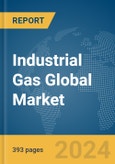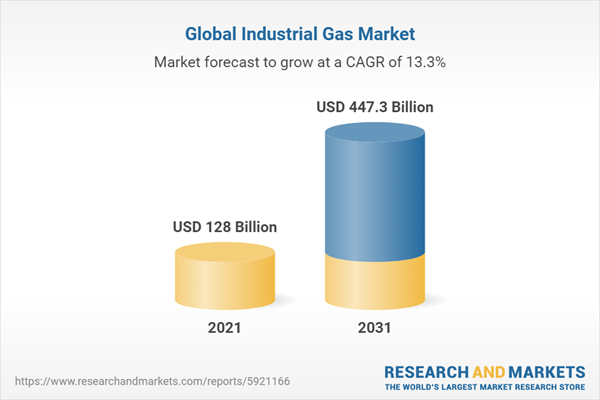The global industrial gas market reached a value of nearly $128.04 billion in 2022, having grown at a compound annual growth rate (CAGR) of 8.2% since 2017. The market is expected to grow from $128.04 billion in 2022 to $240.79 billion in 2027 at a rate of 13.5%. The market is then expected to grow at a CAGR of 13.2% from 2027 and reach $447.31 billion in 2032.
Growth in the historic period resulted from the emerging markets growth, increase in industrialization, rise in government support and increase in demand for frozen and stored food. Factors that negatively affected growth in the historic period were global supply chain disruptions and high costs for gas manufacturing.
Going forward, rapid urbanization, growing natural gas consumption, increasing demand from the healthcare industry and growth in the aerospace industry will drive the market. Factors that could hinder the growth of the industrial gas market in the future include transportation challenges and reductions in free trade.
The industrial gas market is segmented by type into nitrogen, oxygen, carbon dioxide, hydrogen, helium, argon, neon, xenon, krypton and other industrial gas. The nitrogen market was the largest segment of the industrial gas market segmented by type, accounting for 27.4% or $35.02 billion of the total in 2022. Going forward, the argon segment is expected to be the fastest growing segment in the industrial gas market segmented by type, at a CAGR of 17.8% during 2022-2027.
The industrial gas market is segmented by end user industry into chemicals, metallurgy, manufacturing, food and beverage, healthcare, electronics and other end user industries. The manufacturing market was the largest segment of the industrial gas market segmented by end user industry, accounting for 25.9% or $33.13 billion of the total in 2022. Going forward, the healthcare segment is expected to be the fastest growing segment in the industrial gas market segmented by end user industry, at a CAGR of 15.5% during 2022-2027.
The industrial gas market is segmented by mode of supply into bulk, packaged and on-site. The bulk market was the largest segment of the industrial gas market segmented by mode of supply, accounting for 43.4% or $55.62 billion of the total in 2022. Going forward, the on-site segment is expected to be the fastest growing segment in the industrial gas market segmented by mode of supply, at a CAGR of 14.7% during 2022-2027.
Asia-Pacific was the largest region in the industrial gas market, accounting for 44.8% or $57.36 billion of the total in 2022. It was followed by North America, Western Europe and then the other regions. Going forward, the fastest-growing regions in the industrial gas market will be Africa and the Middle East, where growth will be at CAGRs of 22.2% and 17.8% respectively. These will be followed by South America and Asia-Pacific, where the markets are expected to grow at CAGRs of 17.2% and 14.0% respectively.
The global industrial gas market is fairly fragmented, with a large number of small players operating in the market. The top ten competitors in the market made up to 21.57% of the total market in 2022. The market fragmentation can be attributed to the presence of large number of players in different geographies. Prominent players are acquiring the products and entering into partnerships with the other companies to consolidate their market positions across the globe, while others are distributing products. Air Liquide S.A. was the largest competitor with a 7.22% share of the market, followed by Linde Plc with 6.37%, Air Products and Chemicals, Inc with 2.49%, Mitsubishi Chemical Group Corporation with 2.43%, Nippon Sanso Holdings Corporation with 1.72%, Air Water Inc with 0.63%, Messer SE & Co. KGaA with 0.32%, Iwatani Corporation with 0.25%, Gulf Cryo with 0.11% and PT Samator Indo Gas TBK with 0.03%.
The top opportunities in the industrial gas market segmented by type will arise in the oxygen segment, which will gain $28.19 billion of global annual sales by 2027. The top opportunities in the industrial gas market segmented by end user industry will arise in the manufacturing segment, which will gain $32.28 billion of global annual sales by 2027. The top opportunities in the industrial gas market segmented by mode of supply will arise in the bulk segment, which will gain $44.93 billion of global annual sales by 2027. The industrial gas market size will gain the most in China at $33.03 billion.
Market-trend-based strategies for the industrial gas market include use of new generative artificial intelligence (AI) tools in the oil and gas industry, advancements in carbon gas production plant, advanced laser-based technology for accurate and real-time gas quality monitoring in industrial settings, increasing investments in green hydrogen, launch of IoT-enabled medical oxygen plants and advancements in oxygen generators.
Player-adopted strategies in the industrial gas market include strengthening operational capabilities through business expansions, enhancing business operations through securing new contracts and business expansion through mergers and acquisitions.
To take advantage of the opportunities, the analyst recommends the industrial gas companies to focus on use of new generative artificial intelligence (ai) tools in the oil and gas industry, focus on advancements in carbon gas production plants, focus on advanced laser-based technology for accurate and real-time gas quality monitoring, focus on increasing investments in green hydrogen, focus on launch of IoT-enabled medical oxygen plants, focus on advancements in oxygen generators, focus on fast-growing product types, expand in emerging markets, continue to focus on developed markets, focus on competitive pricing, participate in trade shows and events, continue to focus on B2B promotions, focus on urban population and focus on fast-growing end-user industries.
Table of Contents
Executive Summary
Industrial Gas Global Market Opportunities and Strategies to 2032 provides the strategists; marketers and senior management with the critical information they need to assess the global industrial gas market as it emerges from the COVID-19 shut down.Reasons to Purchase
- Gain a truly global perspective with the most comprehensive report available on this market covering 50 geographies.
- Understand how the market is being affected by the coronavirus and how it is likely to emerge and grow as the impact of the virus abates.
- Create regional and country strategies on the basis of local data and analysis.
- Identify growth segments for investment.
- Outperform competitors using forecast data and the drivers and trends shaping the market.
Understand customers based on the latest market research findings.
- Benchmark performance against key competitors.
- Utilize the relationships between key data sets for superior strategizing.
- Suitable for supporting your internal and external presentations with reliable high-quality data and analysis.
Description
Where is the largest and fastest-growing market for industrial gas? How does the market relate to the overall economy; demography and other similar markets? What forces will shape the market going forward? This report answers all these questions and many more.The report covers market characteristics; size and growth; segmentation; regional and country breakdowns; competitive landscape; market shares; trends and strategies for this market. It traces the market’s history and forecasts market growth by geography. It places the market within the context of the wider industrial gas market; and compares it with other markets.
The report covers the following chapters
- Introduction and Market Characteristics: Brief introduction to the segmentations covered in the market, definitions and explanations about the industrial gas market.
- Product Analysis: The product analysis section of the report describes the leading products in the industrial gas market, along with key features and differentiators for those products.
- Supply Chain: Defines and explains the key players in the industrial gas market supply chain.
- Customer Information: The chapter covers recent customer trends/preferences in the global industrial gas market.
- Key Trends: Highlights the major trends shaping the global market. This section also highlights likely future developments in the market.
- Macro-Economic Scenario: The report provides an analysis of the impact of the COVID-19 pandemic, impact of the Russia-Ukraine war and impact of rising inflation on global and regional markets, providing strategic insights for businesses in the industrial gas market.
- Global Market Size and Growth-Global historic (2017-2022) and forecast (2022: 2027,2032F) market values, and drivers and restraints that support and control the growth of the market in the historic and forecast periods.
- Regional and Country Analysis: Historic (2017-2022) and forecast (2022-2027, 2032F) market values and growth and market share comparison by region and country.
- Market Segmentation: Contains the market values (2017-2022) (2022-2027, 2032F) and analysis for each segment by type, by end user industry and by mode of supply in the market. Historic (2017-2022) and forecast (2022-2027) and (2027: 2032) market values and growth and market share comparison by region market.
- Market Segments: Contains the market values (2017-2022, 2022-2027,2032F) for each sub: segment in the industrial gas market.
- Regional Market Size and Growth-Regional market size (2022), historic (2017-2022) and forecast (2022-2027,2032F) market values, and growth and market share comparison of countries within the region. This report includes information on all the regions Asia: Pacific, Western Europe, Eastern Europe, North America, South America, Middle East and Africa and major countries within each region.
- Competitive Landscape: Details on the competitive landscape of the market, estimated market shares and company profiles of the leading players.
- Key Mergers and Acquisitions: Information on recent mergers and acquisitions in the market covered in the report. This section gives key financial details of mergers and acquisitions, which have shaped the market in recent years.
- Market Opportunities and Strategies: Describes market opportunities and strategies based on findings of the research, with information on growth opportunities across countries, segments and strategies to be followed in those markets.
- Conclusions and Recommendations: This section includes recommendations for industrial gas providers in terms of product/service offerings geographic expansion, marketing strategies and target groups.
- Market Background: Chemicals Market - This chapter describes the chemicals market of which the industrial gas market is a segment. This chapter includes the global chemicals market characteristics and (2017-23, 2027F) values and regional analyses for the chemicals market.
- Appendix:This section includes details on the NAICS codes covered, abbreviations and currencies codes used in this report.
Scope
Markets Covered:1)By Type: Nitrogen; Oxygen; Carbon Dioxide; Hydrogen; Helium; Argon; Neon; Xenon; Krypton; Other Industrial Gas
2) By End User Industry: Chemicals; Metallurgy; Manufacturing; Food and Beverage; Healthcare; Electronics; Other End User Industries
3) By Mode Of Supply: Bulk; Packaged; On-Site
Companies Mentioned: Air Liquide S.A.; Linde Plc; Air Products and Chemicals, Inc; Mitsubishi Chemical Group Corporation; Nippon Sanso Holdings Corporation
Countries: China; Australia; India; Indonesia; Japan; South Korea; USA; Brazil; France; Germany; UK; Russia; Czech Republic; Poland; Romania; Ukraine;Austria; Belgium; Denmark; Finland; Ireland; Italy; Netherlands; Norway; Portugal; Spain; Sweden; Switzerland; Egypt; Nigeria; South Africa; Iran; Israel; Saudi Arabia; Turkey; UAE; Argentina; Chile; Colombia; Peru; Canada; Mexico; Vietnam; Thailand; Singapore; Philippines; New Zealand; Malaysia; Hong Kong
Regions: Asia-Pacific; Western Europe; Eastern Europe; North America; South America; Middle East; Africa
Time-series: Five years historic and ten years forecast.
Data: Ratios of market size and growth to related markets; GDP proportions; expenditure per capita; industrial gas indicators comparison.
Data segmentations: country and regional historic and forecast data; market share of competitors; market segments.
Sourcing and Referencing: Data and analysis throughout the report is sourced using end notes.
Table Information
| Report Attribute | Details |
|---|---|
| No. of Pages | 393 |
| Published | January 2024 |
| Forecast Period | 2021 - 2031 |
| Estimated Market Value ( USD | $ 128 Billion |
| Forecasted Market Value ( USD | $ 447.3 Billion |
| Compound Annual Growth Rate | 13.3% |
| Regions Covered | Global |
| No. of Companies Mentioned | 46 |









